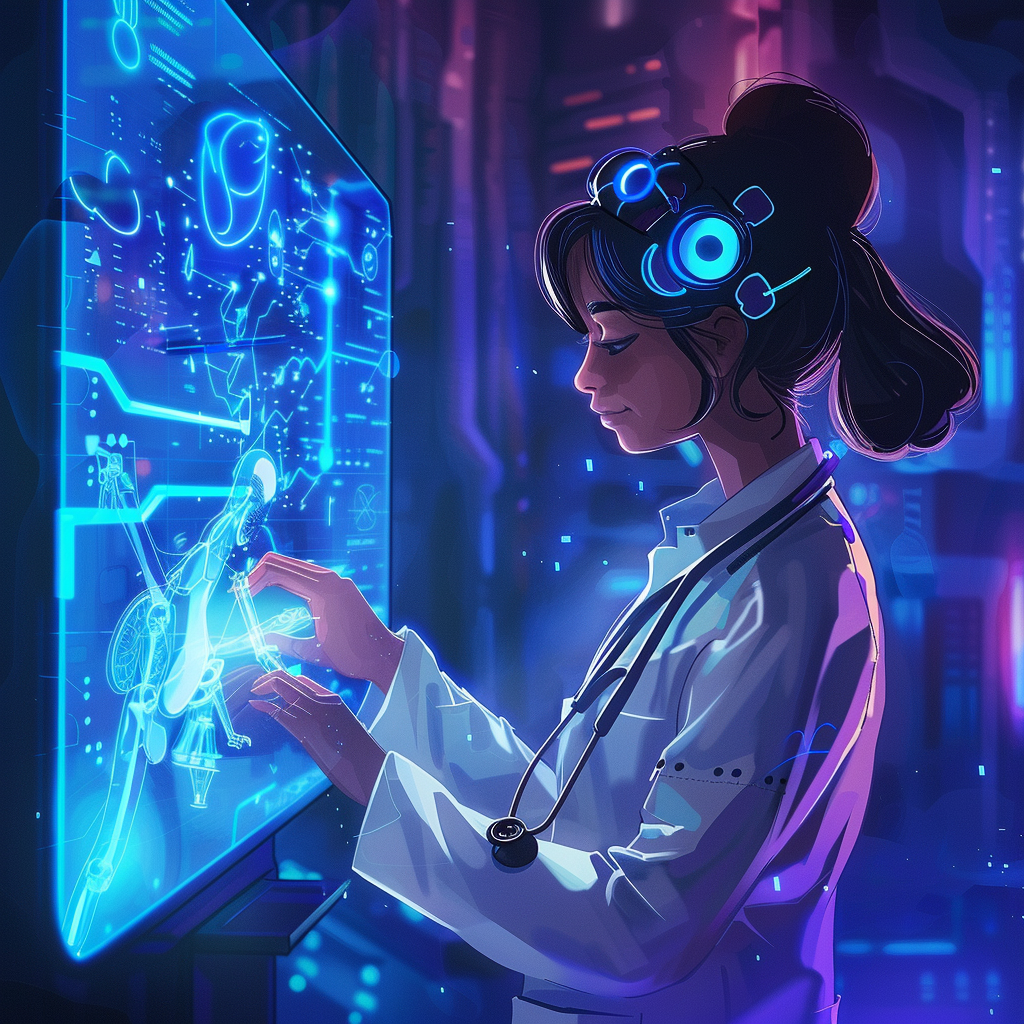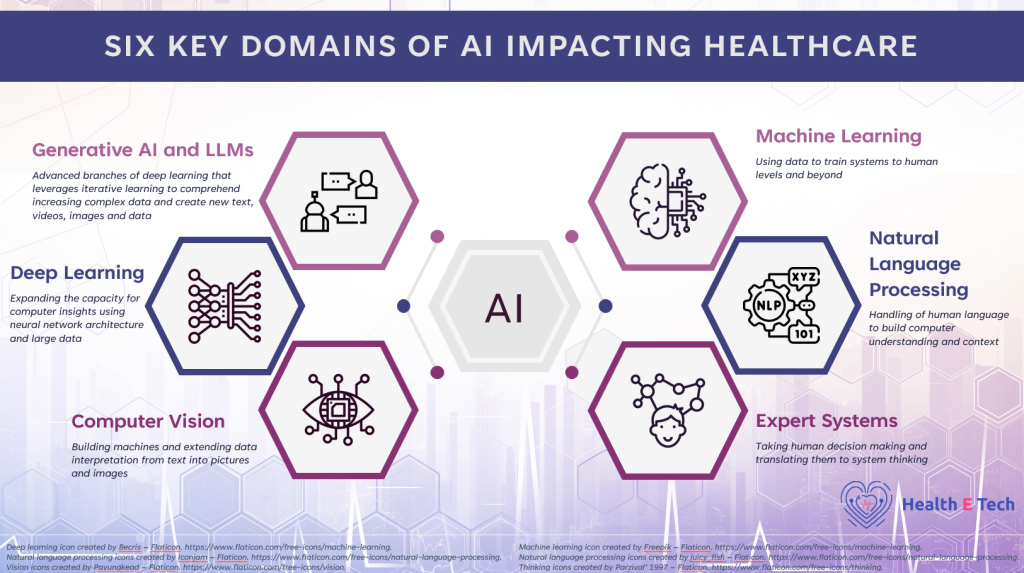
Six AI Technologies Shaping Modern Healthcare
|
Beyond Buzzwords Series
|
article
In this Beyond Buzzwords article series, we will take a critical look at how artificial intelligence technologies, are positioned to practically affect the progress that is already happening across the healthcare system, to estimate the rate of acceleration they could pose. This analysis will help us understand where the smart investments are in the short term, and where we can best use resources to prepare our front-line clinicians and staff for their impact on their daily practice.
This first article provides a high-level overview to the key concepts, with subsequent deep dive articles examining use cases in the literature to follow, we will learn how innovators are practically implementing the technology and the preliminary results they are seeing.

Introduction
The acute focus on artificial intelligence (AI) has penetrated all walks of professional life, from corporate strategy and marketing to the endless LinkedIn articles and training courses. It is becoming the face of seemingly every new healthcare investment, and it can be fatiguing and overwhelming. Especially for healthcare professionals who rely on technology to deliver care but are not responsible for building technology and workflows using it.
Let’s slow it down and consider what the commonly discussed concepts across AI are, what they fundamentally mean, and how they are positioned to start impacting different facets of healthcare and clinical practice. Although we are looking at these terminologies independently, as you read them, you will likely realize that there is extensive overlap in how they are used in products and capabilities you are familiar with, and in fact, that is where their true power lies.

Machine Learning
Machine Learning (ML), simply put, is how computers and algorithms learn. They are systems that improve the performance of a task when given examples of ideal performance, or that improve performance with repeated experience, similar to human learning. Although there are many types of ML, with varying costs and complexity to implement, the basic machine learning loops are similar: (1) make a prediction; (2) test the prediction; (3) measure the error; and (4) modify your parameters. New types of learning model architecture and the rise in affordable cloud computing has increased accessibility of powerful models into the public and private sectors and are a key reason we find ourselves in an “AI Revolution”.
The type of data and the outcome you want will guide the proper method of machine learning that you will want to leverage for a given use case. A key parameter is understanding the extent to which your data is labelled. Data Labeling is adding meaningful tags to raw data that interprets or contextualizes the raw data, which can be used by the ML systems to drive outcomes. A simple example is if you take CT scans and add a label for positive or negative for lesions. Some ML methodologies require the data to be labeled, which means either humans or computers will need to work the raw data as a pre-requisite.
Machine Learning is a critical technology that drives this new emphasis on AI, and is often used interchangeably with AI in parlance, for good reason. It constitutes an over-arching subfield of artificial intelligence with substantial impacts on all facets of life, including healthcare. The extent to which ML is used by organizations and patients will be a critical factor for patient outcomes.
Care Acceleration Rating: High

Natural Language Processing
Natural Language Processing (NLP) is the domain of AI concerning how computers understand “human” information. It involves the handling of human language, or data that resembles human language, which includes writing, speaking and organizing thought. You can think of NLP as the interface of converting human concepts into computer concepts, and it is critical for healthcare applications, such as interpretation and summarization of electronic health records (EHRs) into computer-friendly concepts. Natural language processing is often used in conjunction with speech recognition, which parses spoken language into text, and vice versa.
NLP can be subdivided into Natural Language Understanding (NLU) and Natural Language Generation (NLG), which are both central technologies for some of the most widely discussed use cases in healthcare, such as clinical documentation assistance, information retrieval and conversion of clinical records into computer-friendly named entities, on which other processes can be run. Proper implementation of NLP capabilities will likely require the assistance of front-line users, such as clinicians and administrative personnel, to influence implementation design and for thorough testing, especially in the short term. Many organizations are implementing NLP tools to alleviate administrative burdens for high volume, repetitive tasks that are central to burnout.
Care Acceleration Rating: High

Expert Systems
In the context of artificial intelligence, an expert system attempts to simulate the reasoning of human experts in niche fields. Computer engineers and product professionals will replicate practice heuristics, work algorithms and experience-based decision trees that exist in the minds of human experts and extract them into computer tools, such as statistical models and decision support engines.
Within healthcare, expert systems are found across the continuum of practices, whether it is in-patient or ambulatory services, embedded into EHRs and pharmacy management systems (PMS). They have historically been programmed using if-then rules or decision trees within healthcare applications and aim to increase the quality of care and reduce errors. Many of the emerging technologies we discuss will likely improve the quality of expert systems and serve as an entry point into clinical workflows, since they are a familiar baseline from which you can grow end user engagement with advanced tools.
Clinicians and experts are often part of the building of these systems but may also be increasingly involved in their usability testing, quality testing, training and implementation support. Clinical decision support and protocol design within healthcare already largely uses expert systems and will continue to play an important role in healthcare practice. However, the proliferation and advancement of expert systems seems like it will be secondary to other AI concepts, and the lines will likely blur to end users between expert systems and other AI technologies within practice.
Care Acceleration Rating: Medium

Computer Vision
Computer vision is a combination of hardware and algorithms used to process visual data, such as images or videos, into computer-interpretable information. There are a few sub-processes, such as image acquisition, image pre-processing and feature extraction, which can yield key capabilities, such as automated classification of medical images for diagnosis.
Clinical image analysis can increase accuracy and decrease the time required by human agents today to interpret images and convert them into actions. Studies today already demonstrate the ability of AI systems to meet or exceed human performance in image diagnosis for several use cases, such as diabetic retinopathy and pathology. Computer vision can also decrease time for clinical intervention by efficiently preparing images for human interpretation, such as planning cancer treatment via AI-enhanced scan images. When paired with cameras, the use cases for computer vision become even grander, such as smart operating rooms and HIPAA-compliant patient identification systems, although this technology will need more evaluation (both from an accuracy and patient acceptance perspective) before it is implemented more broadly.
In the short term, many organizations are already looking at how to implement computer vision enhancements into workflows to aid human decision making for clinical interventions, and early study data indicates a promising technology that could one day replace human interpretation in some use cases. With advancements in hardware and processing capacity of computer systems, the abilities for computer vision applications are growing rapidly. For clinicians who work in fields that commonly use images, you should expect to see investments in computer vision applications impact their practice sooner rather than later.
Care Acceleration Rating: Medium

Deep Learning
Nested within the fields of AI and ML, deep learning refers to an elaborate sub-form of computer learning that uses layered neural network architecture to provide increased accuracy and specificity of trained systems. It is responsible for many of the applications and services that improve automation and analytics we have seen and is appealing because it reduces the need for human intervention in several steps of processing. The key is deep learning uses algorithms to perform a process called backpropagation, which calculates errors in prediction and adjusts model weights and biases resulting in an iteratively better model.
There are key drawbacks to deep learning that you should be aware of. This flavor of machine learning requires an exceptionally large amount of data of sufficient quality for training. Additionally, there are cost, build complexity, processing resources, time and experts (in high demand) that are needed.
Deep learning processes alone will have niche applications to healthcare but will most likely be a component of some of the other AI capabilities we have outlined in this article. It is more likely that deep learning solutions will be blind to clinicians, end users and executives, and be implemented when necessary to achieve a use case that cannot otherwise be solved for.
Care Acceleration Rating: Low – Medium

Generative AI and LLMs
Going one more layer down, generative AI is a branch of deep learning which uses large language models (LLM), in conjunction with other AI domains like NLP, to interpret and generate new data, such as images, video and text. It is likely the most common AI terminologies used and sought after today, driven by the popularity of generative AI chatbots, such as ChatGPT, Copilot and Claude.
The key technology here are the LLMs, which are unique neural networks trained on massive amounts of data and contain billions of internal settings called parameters. Most generative AI tools use a breakthrough computer architecture, called transformers, that function like the brain of the operation at a reduced computing cost than earlier architecture. Generative AI is a robust mathematical and probability model which has seemingly endless applications, including healthcare.
Organizations are eager to see the power of these emerging technologies harnessed to rapidly elevate the standards of care and increase the efficiency of their workforce to improve patient outcomes. These tools are making their way into all sorts of use cases, from patient-facing chatbots to clinician charting, and everything in between. The pressure to get these tools into practice has led to large investments by organizations, who have to build solutions, minimize risks (such as hallucination management, HIPAA compliance) and make key strategic decisions (such as which product to use, whether to use domain-specific LLMs or train their own) all at the same time. Generative AI and LLMs certainly represent the AI capabilities with the largest driving momentum we see today, and as society grapples with assimilating generated AI content into our lives, there will be an expectation that healthcare is harnessing the power that is visible to the public.
Care Acceleration Rating: Medium – High
Conclusion
It is important to remember that no one knows exactly how these technologies will impact healthcare. There is undoubtedly urgency to adopt AI into clinical practice. However, great care, testing and expertise needs to be taken to ensure generate AI is harnessed appropriately and ethically, and most critical is that the trust of our patients and clinicians is not lost by cutting corners in the pursuit of speed for implementation. We are facing a unique situation as AI adoption is coming from bottom-up and simultaneously from the top-down. Senior leaders at companies are building strategic partnership and acquisitions to build AI strategy, and at the same time end users are hearing about and finding ways to experiment and integrate tools into their daily routines to save time and increase quality of decision making.
Clinicians and technologists should be collaborating harmoniously with executives on driving technology strategy and investments. Patient care is at an inflection point, with the potential for rapid and permanent improvements if the technology can be properly harnessed.
References
Bibliography
- Bringsjord, Selmer, and Govindarajulu, Naveen Sundar. “Artificial Intelligence (Stanford Encyclopedia of Philosophy).” Stanford.edu, 2018, plato.stanford.edu/entries/artificial-intelligence/#HistAI.
- Salian, Isha. “NVIDIA Blog: Supervised vs. Unsupervised Learning.” NVIDIA Blog, 2 Aug. 2018, blogs.nvidia.com/blog/supervised-unsupervised-learning/.
- “What Is Data Labeling? – Data Labeling Explained – AWS.” Amazon Web Services, Inc., aws.amazon.com/what-is/data-labeling/.
- DeepLearning.AI. “Natural Language Processing (NLP) – a Complete Guide.” Www.deeplearning.ai, 11 Jan. 2023, www.deeplearning.ai/resources/natural-language-processing/.
- Salem H, Soria D, Lund JN, Awwad A. A systematic review of the applications of Expert Systems (ES) and machine learning (ML) in clinical urology. BMC Med Inform Decis Mak. 2021 Jul 22;21(1):223. doi: 10.1186/s12911-021- 01585-9. PMID: 34294092; PMCID: PMC8299670.
- “Medical Expert System – an Overview | ScienceDirect Topics.” Www.sciencedirect.com, www.sciencedirect.com/topics/computer-science/medical-expert-system.
- Singh, Balwant. “What Is Computer Vision | Chooch.” Vision AI | Generative AI for Computer Vision | Chooch, 5 Sept. 2023, www.chooch.com/blog/what-is-computer-vision/. Accessed 4 Apr. 2024.
- Bajwa J, Munir U, Nori A, Williams B. Artificial intelligence in healthcare: transforming the practice of medicine. Future Healthc J. 2021 Jul;8(2):e188-e194. doi: 10.7861/fhj.2021-0095. PMID: 34286183; PMCID: PMC8285156.
- Goldsmith, Jeffrey, et al. “The Value of Computer Vision in Healthcare | HIMSS.” Www.himss.org, 22 July 2021, www.himss.org/resources/value-computer-vision-healthcare.
- Habehh H, Gohel S. Machine Learning in Healthcare. Curr Genomics. 2021 Dec 16;22(4):291-300. doi: 10.2174/1389202922666210705124359. PMID: 35273459; PMCID: PMC8822225.
- IBM. “What Is Deep Learning?” Www.ibm.com, 2023, www.ibm.com/topics/deep-learning.
- “What Is Deep Learning?” Codecademy, www.codecademy.com/article/what-is-deep-learning. Accessed 4 Apr. 2024.
- McKinsey. “What Is AI? .” Www.mckinsey.com, McKinsey & Company, 24 Apr. 2023, www.mckinsey.com/featured-insights/mckinsey-explainers/what-is-ai.
Icons
Machine learning icons created by Freepik – Flaticon
Natural language processing icons created by juicy_fish – Flaticon
Computer Vision icons created by Payungkead – Flaticon
Expert Systems icons created by Parzival’ 1997 – Flaticon
Gen AI icons created by Freepik – Flaticon
Deep Learning icons created by Becris – Flaticon
